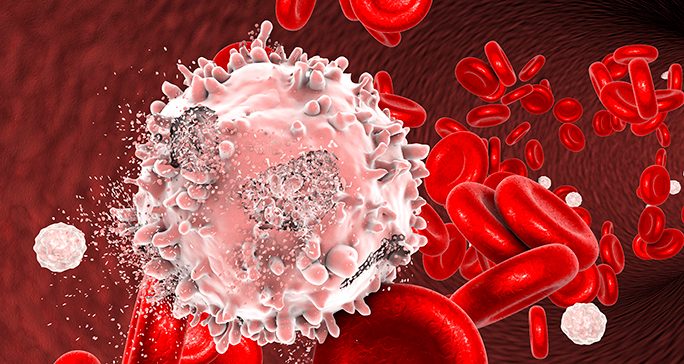request an appointment online.
- Diagnosis & Treatment
- Cancer Types
- Leukemia
- Leukemia Treatment
Get details about our clinical trials that are currently enrolling patients.
View Clinical TrialsLeukemia Treatment
As one of the world’s top cancer centers, MD Anderson brings together internationally renowned physicians with a specialized support team to customize your care. These highly experienced experts communicate and collaborate daily, ensuring you receive comprehensive leukemia treatment.
Many of these doctors focus not just on leukemia, but on specific types of leukemia, giving them a deep level of knowledge and experience to draw on when designing treatment plans.
The goal of leukemia treatment is to put the disease into remission and ultimately cure the patient. For leukemia, complete remission usually means that the patient’s bone marrow has no detectable microscopic evidence of the disease and his or her blood counts have returned to normal.
Even with normal blood counts, many leukemia patients require ongoing maintenance therapy to stay in remission. In some cases, patients in remission undergo a stem cell transplant to maintain remission.
Patients who remain in continued complete remission for an extended period of time are considered cured. This means they have an extremely low chance of recurrence. The exact amount of time it takes to be considered cured differs among leukemia types, but it is typically measured in years.
Chemotherapy
Chemotherapy drugs kill cancer cells, control their growth or relieve disease-related symptoms. Chemotherapy may involve a single drug or a combination of two or more drugs, depending on the type of cancer and how fast it is growing.
Learn more about chemotherapy.
Radiation therapy
Radiation therapy uses power beams of energy to kill cancer cells. Since leukemia cells travel in the blood stream, there is no distinct tumor to target with radiation therapy like there is for other cancers. Instead, radiation is typically used when the disease has spread to the central nervous system.
Learn more about radiation therapy.
Stem cell transplantation
A stem cell transplant (also known as a bone marrow transplant) is a procedure that replaces cancerous bone marrow with new, healthy bone marrow stem cells. Stem cell transplants are usually given after an intense round of chemotherapy that kills the patient’s existing bone marrow cells and prepares the body for transplant. Patients usually must stay in the hospital for three to four weeks after the procedure.
A stem cell transplant may be needed for patients whose leukemia has returned or has not responded to standard treatments. It may also be recommended if the patient has a high-risk form of leukemia that would make a cure with standard treatments unlikely. This treatment can be physically challenging, so it is typically not given to patients who are older or otherwise unhealthy.
Learn more about stem cell transplants.
CAR T cell therapy
T cells are a type of immune system cell. They help the immune system respond to disease and directly kill diseased cells. In Chimeric Antigen Receptor (CAR) T cell therapy, T cells are modified so they are able to recognize and attack cancer cells.
Learn more about CAR T cell therapy.
Targeted therapy
Targeted therapy drugs are designed to stop or slow the growth or spread of cancer. This happens on a cellular level. Cancer cells need specific molecules (often in the form of proteins) to survive, multiply and spread. These molecules are usually made by the genes that cause cancer, as well as the cells themselves. Targeted therapies are designed to interfere with, or target, these molecules or the cancer-causing genes that create them.
Learn more about targeted therapy.
Clinical trials
As a top-ranked cancer center, MD Anderson offers multiple clinical trials for leukemia. Many of these cannot be found anywhere else. Trials explore new drug combinations and new drugs, including targeted therapies and immunotherapies.
Learn more about clinical trials.
Some cases of leukemia can be passed down from one generation to the next. Genetic counseling may be right for you. Learn more about the risk to you and your family on our genetic testing page.
Learn more about leukemia:


Featured Podcast:
Tracking leukemia with minimal residual disease (MRD)
Naveen Pemmaraju, M.D., and Fadi Haddad, M.D., explain how minimal residual disease, or MRD, is helping doctors monitor leukemia more precisely and personalize treatment.
In the News
Treatment at MD Anderson
Clinical Trials
MD Anderson patients have access to clinical trials offering promising new treatments that cannot be found anywhere else.
Becoming Our Patient
Get information on patient appointments, insurance and billing, and directions to and around MD Anderson.
Counseling
MD Anderson has licensed social workers to help patients and their loved ones cope with cancer.
What is minimal residual disease (MRD)?
After completing a course of treatment, there are few words that sound better to a patient than “complete remission.” It’s an indication that the treatment has worked, and there is no evidence of cancer based on scans or lab tests.
However, there is a different phrase that can be somewhat confusing to patients – minimal residual disease (MRD). This term is used often by physicians when treating patients with blood cancers, such as leukemia, lymphoma or multiple myeloma.
MRD refers to cancer cells remaining after treatment that can’t be detected by those same scans or tests. But what exactly does it mean for patients?
To learn more about minimal residual disease, we spoke with leukemia specialist Ghayas Issa, M.D., of MD Anderson’s Myelodysplastic Syndromes (MDS) and Acute Myeloid Leukemia (AML) Moon Shot® team. Here’s what he shared.
How do you explain minimal residual disease to patients?
Minimal residual disease is a small number of cancer cells left in the body after treatment. These cells have the potential to come back and cause relapse in our patients.
In leukemia, for example, we look for response after chemotherapy treatment by looking under the microscope for cancer cells present in a bone marrow biopsy. When there are no cancer cells present, and the bone marrow is making normal cells, we call that a complete response.
However, we know that if we don’t do further treatment, a portion of these patients will experience a relapse. That means there were some leukemia cells hiding that we weren’t able to detect under the microscope. That is minimal residual disease, or perhaps a better term is measurable residual disease. Typically, these cells don’t cause any symptoms, but they have the potential to lead to a relapse.
If we can’t detect minimal residual disease under the microscope, how do we test for it?
We now have much more sensitive assays available to us that allow us to quantify MRD. These could include next generation genetic sequencing, where we can analyze bone marrow samples for genetic mutations. If there are mutations present, that means there is minimal residual disease, even though we can’t see anything under the microscope.
We can also use a technique called flow cytometry, which allows us look in the same samples for abnormal proteins on the surface of cells. By determining how many cells have abnormal proteins detected, we can get a better sense of residual cancer cells. Using these new assays, we routinely try to quantify whether a patient has MRD following standard treatment.
What are the implications for a patient who has evidence of minimal residual disease after treatment?
That’s difficult to say, because it’s not the same across all types of blood cancers. Some patients with MRD will have different responses than others. In general, if a patient has MRD, we need to do additional treatments to work toward the best outcome. If we do nothing, we know that the residual cells will cause a relapse.
It also depends on the timing of the MRD test. In my leukemia patients, if there is MRD after the first cycle of chemotherapy treatment, it tells me that I probably need to give more treatment — either a different medication or a different course of treatment. If there is still MRD after many rounds of chemotherapy, that is an indication that the patient may need to have a stem cell transplant, when otherwise it might not have been appropriate.
Ultimately, MRD is a marker that we need to be more aggressive in our treatment to try and prevent the cells from coming back.
What can cancer researchers learn from the residual cancer cells?
We can learn a great deal. These cancers can adapt to treatment, meaning the cancer we start with is not the same as what we have after treatment. By studying the minimal residual disease, we can learn more about what is left after treatment.
That helps us to do several things. First, it allows us to modify our treatment, either by adding medications that target specific vulnerabilities in the cancer cells, including medications that are especially good at killing even residual cells, or doing a stem cell transplant, which is able to take care of residual cells.
Currently, I work with a wonderful team through the MDS and AML Moon Shot to study these residual cancer cells in order to find new vulnerabilities. Through our research, we’re hoping to identify new treatments that we can use in the future to specifically eliminate minimal residual disease.
Request an appointment at MD Anderson online or by calling 1-877-632-6789
What’s new in leukemia research?
Leukemia is an overarching term encompassing several subtypes of blood cancers. Blood cells are produced in the bone marrow, the spongy material inside bones. The bone marrow contains immature stem cells that develop and mature to become red blood cells, platelets, or different types of white blood cells.
When mutations occur in bone marrow stem cells, it can interfere with the body’s normal production of blood cells. This can start as a disease or disorder classified as a pre-leukemia state (and may or may not progress to leukemia), or it can start as leukemia.
Fadi Haddad, M.D., assistant professor of Leukemia, walked us through a few updates in leukemia research being presented at the 2024 American Society of Clinical Oncology Annual Meeting (ASCO).
Oral use of a known drug to treat myelodysplastic syndrome
Myelodysplastic syndrome (MDS) is a pre-leukemia state. Haddad explains, “Myelo means related to the bone marrow, and dysplasia means abnormal growth. So, in patients with MDS, the bone marrow is abnormal. If left untreated, it could progress to acute myeloid leukemia (AML).”
Azacitidine is approved as a treatment for MDS. “It’s given either as an intravenous (IV) infusion, or it's given as subcutaneous injections, meaning under the skin,” says Haddad. Both options could be inconvenient for some patients. “The IV infusion requires patients to come to the hospital repeatedly as long as they are receiving the treatment. The subcutaneous injections can be done at home, but they can cause hematomas and pain in the skin at the site of the injection.” Compounding the inconvenience, patients may receive the treatment for several months or years.
In a study (Abstract 6509) presented by Guillermo Garcia-Manero, M.D., professor of Leukemia, researchers looked at the safety and efficacy of taking azacitidine orally, rather than via infusion or injection, for patients with low- or intermediate-risk MDS. While azacitidine taken orally is approved for maintenance therapy in patients with AML in remission, it is not currently approved for the treatment of MDS.
The study found that oral delivery of azacitidine had side effects similar to what we’ve seen with oral azacitidine in previous studies. The preliminary efficacy of the drug was also good. “Close to 30% of patients saw hematologic improvement, which supports the continued evaluation of oral azacitidine in low- or intermediate-risk myelodysplastic syndrome,” Haddad notes.
An investigational drug for acute myeloid leukemia (AML) treatment
One area of interest in AML research is refining treatment both for older patients who need lower intensity treatment and for patients with AML that has come back (relapsed) or is not responding to treatment (refractory). The current standard of care is a combination of the drug venetoclax with either azacitidine or decitabine.
“We've been investigating several compounds that are added to one of these combinations,” Haddad notes. A study (Abstract 6511) presented by Maro Ohanian, D.O., associate professor of Leukemia, looks at the preliminary results of a clinical trial combining standard venetoclax and decitabine treatment with a new drug called BP1001. “Adding BP1001 is supposed to enhance the cancer cell sensitivity to chemotherapy, so the effect of the chemotherapy will be stronger,” says Haddad.
The study looked at this three-drug combination in older patients with newly diagnosed AML as well as in patients of all ages with relapsed or refractory AML. “This triplet combination was safely administered to patients in both groups without new or unexpected toxicities,” Haddad summarizes. “The study is continuing enrollment and will expand to enroll more patients to collect data on efficacy.”
Examining safety concerns for bone marrow transplants following treatment of AML with a known compound
Another treatment option for some subtypes of AML is a drug called gemtuzumab ozogamicin (GO). GO is a type of molecule known as an antibody drug conjugate. This means that two parts make up GO: an antibody that attaches to a biomarker on cancer cells and a chemotherapy drug. “When we give patients this kind of treatment, the antibody attaches to the leukemia cell, and the drug enters the leukemia cell and leads to its death,” Haddad explains.
The Food and Drug Administration (FDA) approved GO in 2017, but there have been concerns about side effects for patients who take GO and later receive bone marrow transplants. “One of the side effects that we should pay attention to is hepatotoxicity — negative impacts to the liver. In rare cases, it can cause hepatic veno-occlusive disease, or VOD. This is a very serious condition that can lead to liver failure if left untreated,” says Haddad. Patients who take GO may be at a higher risk of developing VOD when they go on to receive bone marrow transplants.
To investigate these safety concerns, Partow Kebriaei, M.D., professor of Stem Cell Transplantation, led a multi-center effort to collect and analyze data (Abstract 6516) from adult patients with AML who received GO and went on to undergo bone marrow transplantation. “The rates of VOD and the rates of mortality are similar to patients who got a transplant but did not take GO,” says Haddad. “This means the drug did not add much toxicity compared to what we see without the drug, and GO appears to be safe for use.”
Factors in myelofibrosis outcomes, treatments for chronic lymphocytic leukemia, and more
Two other research talks come from William Wierda, M.D., Ph.D., professor of Leukemia, and Julie Braish, M.D., a fellow in Leukemia. Wierda led the CAPTIVATE Phase II clinical trial (Abstract 7009). This trial looked at the combination of venetoclax and ibrutinib in patients with chronic lymphocytic leukemia and small lymphocytic lymphoma. Braish, working with Lucia Masarova, M.D., assistant professor of Leukemia, examined factors affecting outcomes in patients with myelofibrosis, another pre-leukemia state (Abstract 6514). These factors include the variant allele frequency of the JAK2 gene mutation and the presence or absence of cytopenias (lower than normal blood cell counts).
In addition to these presentations, MD Anderson researchers are giving two other oral presentations and numerous posters on leukemia research at the 2024 American Society of Clinical Oncology Annual Meeting. “Our presentations at ASCO represent the impact our research is having in pushing a really broad range of leukemia and pre-leukemia research and treatment forward,” says Haddad.
Learn about research careers at MD Anderson.
myCancerConnection
Talk to someone who shares your cancer diagnosis and be matched with a survivor.
Prevention and Screening
Many cancers can be prevented with lifestyle changes and regular screening.
Help #EndCancer
Give Now
Donate Blood
Our patients depend on blood and platelet donations.
Shop MD Anderson
Show your support for our mission through branded merchandise.



